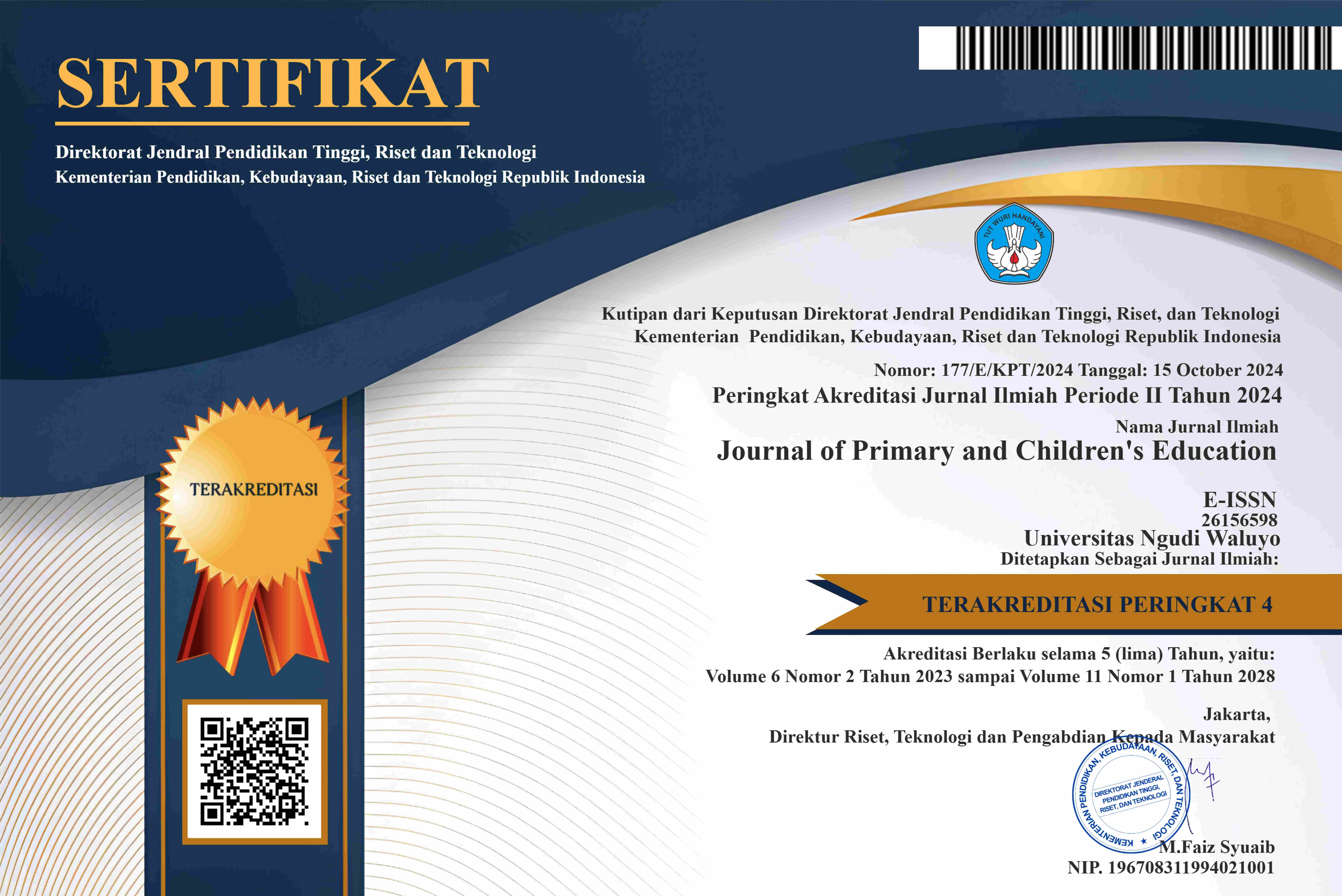KEEFEKTIFAN MODEL TWO STAY TWO STRAY BERBANTU MEDIA RODA PINTAR MATEMATIKA TERHADAP HASIL BELAJAR
DOI:
https://doi.org/10.35473/jnctt.v2i1.51Abstract
The purpose of this research is to know the effectiveness of Two Stay Two Stray model assisted media of smart mathematics wheel to hail to learn fourth grader of SD Negeri Plelen 02 Batang. This research is a quantitative research using one group pretest posttest design research design. The results of the test of learning showed that the results of learning results of students who use the Two Stay Two Stray model auxiliary media mathematical wheels reach a classical percentage of 92%. The posttest score of 76.20 and the minimum completeness criterion (KKM) 70, obtained by t = 8.64 with n = 25, and ttabel 1.710. So the calculation results are known 8.64> 1.710. Based on the test criteria when obtained t count> ttable is 8.64> 1.710 so H0 diterima. In conclusion Two Stay Two Stray model auxiliary media effective mathematics media to the results of the fourth grade students of SD Negeri Plelen 02 Batang.
Keywords: Two Stay Two Stray models, math smart wheels, learning outcomesÂReferences
Heruman. 2016. Model Matematika di Sekolah Dasar. Bandung: Remaja Rosdakarya
Azhar Arsyad. 2014. Media Pembelajaran. Jakarta : Raja Grafindo Persada
Arikunto, Suharsimi. 2013. Dasar-Dasar Evaluasi Pendidikan, Jakarta :Bumi Aksara.
Susanto,Ahmad. 2016. TeoriBelajar dan Pembelajaran di Sekolah Dasar, Jakarta:Prenadamedia Group.
Sugiyono. 2010. Metode Penelitian Pendidikan Pendekatan Kuantitatif, Kualitatif, dan R&D. Bandung: Alfabeta.
Erlinda,Yunita. 2017. “keefektifan model pembelajaran Numbered Heads Together (NHT) Berbantu Media Roda Keberuntungan terhadap hasil belajar Matematika Siswa Kelas V SDN Candi 01 Semarang.â€journal penelitian pendidikan (1).101.Wijana,I Komang. 2014. “Pengaruh Model Pembelajaran Two Stay-Two Stray terhadap Hasil Belajar IPA Siswa kelas V SD Kaliasem Kecamatan Banjar Kabupaten Buleleng.†e-journal mimbar .vol 2 (1)
Indriyani,Cici. 2011. “Peningkatan Kualitas Pembelajaran IPS Dengan Model Pembelajaran Two Stay Two Stray Pada Siswa Kelas IV SD Tambakaji Kecamatan Ngaliyan Kota Semarangâ€. Jurnal pendidikan kreatif. Vol 1 (2)
Novianti,Ria. 2015. “Pengembangan Permainan Roda Putar Untuk Meningkatkan Kemampuan Berhitung Angka Anak Usia 5-6 Tahunâ€. Educhild vol 4 (1)
Hernawan,Asep.2007.Media Pembelajaran,Bandung:Upi press
Hamdani.2011.Strategi Belajar Mengajar,Bandung:Pustaka setia
Suwarsih,Erna.2006.Model Pembelajaran Matematika.Bandung:Upi press
Sundayana,Rostina.2015.Media dan Alat Peraga Dalam Pembelajaran Matematika.Bandung:Alfabeta
Daryanto.2012.Model Pembelajaran Inovatif.Yogyakarta:Gava Media
Djamarah,Syaiful.2006.Strategi Belajar Mengajar.Jakarta:Rineka Cipta
Sudjana,Nana.2006.Penilaian Hasil Proses Belajar Mengajar.
Bandung:Remaja Rosdakarya
Huda,Miftahul.2013.Model-Model Pengajaran Dan Pembelajaran.
Yogyakarta:Putaka Pelajar
Suprijono,Agus.2014.Cooperative Learning.Yogyakarta:Pustaka Pelajar
Slameto.2010.Belajar Dan Faktor-Faktor yang Mempengaruhinya.
Jakarta:Rineka Cipta
Djamarah,Syaiful.2010.Strategi Belajar Mengajar.Jakarta:Rineka Cipta
Uno,Hamzah.2011. Perencanaan Pembelajaran. Jakarta: PT. Bumi Aksara
Shoimin,Aris.2014.Model Pembelajaran Inovatif Dalam Kurikulum 2013. Yogyakarta: Ar-Ruzz Media.
Published
How to Cite
Issue
Section
License
Copyright notice:
- Authors retain copyright and grant the journal right of first publication with the work simultaneously licensed under Creative Commons Attribution License that allows others to share the work with an acknowledgement of the work's authorship and initial publication in this journal.
- Authors are able to enter into separate, additional contractual arrangements for the non-exclusive distribution of the journal's published version of the work (e.g., post it to an institutional repository or publish it in a book), with an acknowledgement of its initial publication in this journal.
- Authors are permitted and encouraged to post their work online (e.g., in institutional repositories or on their website) prior to and during the submission process, as it can lead to productive exchanges, as well as earlier and greater citation of published work (The Effect of Open Access)







